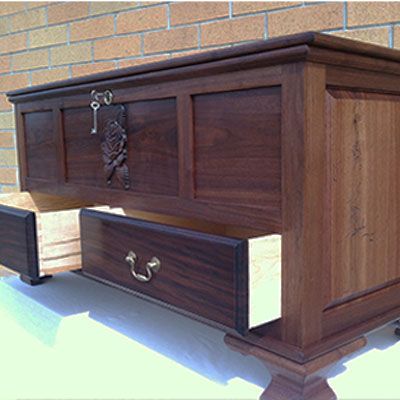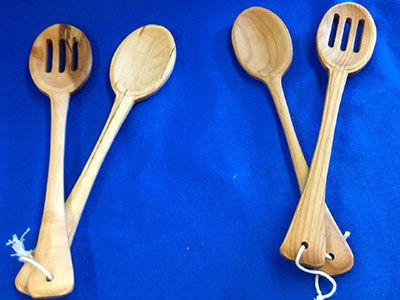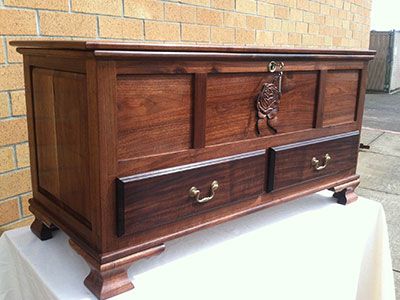
As children return to school after the summer, it seems a good time to share the story of High School Teacher John Stearns. John who teaches at a rural school in Oregon (USA) has a passion for woodwork and CNC machining and with a practical industry based approach to his class; he is inspiring his pupils too. Before we look at some of the projects they work on, John tells us a bit about himself, his class and how he found his way into teaching.
Amity High School is a small rural school the Willamette Valley of Oregon. The high school serves around 300 students each school year with around 85 students in my annual class. I teach ‘Woods 1-4’, ‘Manufacturing’, and a Middle School class each year.
Students come into ‘Woods 1’ each year generally with very little experience in the shop and learn how to safely use the tools in the shop while building five projects in the first semester. One of those required projects includes a C.N.C. design, either added to one of their projects or a stand-alone piece. I make students get a taste of C.N.C. early in their woodworking careers.
As students’ progress in my classes, C.N.C. increasingly becomes a part of the process. In my Manufacturing class, students have to make, market and sell a wood-based product. Increasingly, students have chosen to use the C.N.C. to build their manufacturing projects. The speed of production, repeatability, and quality control has added value to them and their customers. Before teaching, I was the youth pastor in Amity. I volunteered in the shop class for the former teacher, because I love woodworking and it was a great way to get into the high school.
I respected the former teacher, but I felt the class was very craft-based, and I knew there was more that could be done with the pupils and the program. I wanted to bring industry into the classroom, even if students don’t go into industry, the soft-skills and lessons they can learn from having it in their education is a win/win for students and the school.
Given his enthusiasm for showing his students the benefits of using a CNC machine we wondered how John first discovered this technology.
I think the first time I saw C.N.C. was at a Woodworking Show in Portland before I became a teacher. Like most woodworkers, I love new products and new technology. I knew it would be a challenge to learn the software- but I have never shied away from a challenge and I love to learn new things.
The possibilities of what you can create are what inspired me to start using C.N.C. in my classroom. I did a lot of research- probably too much, but one thing I kept coming back to- was simplicity. Students need a step by step approach to solve complex problems. What I found is that Vectric software gave me that step by step education I can teach to my students and then my students could teach each other.
With a class to teach it’s important that a good selection of tools are available for the students to complete their projects. We asked John to describe what equipment and software he has in the workshop and why he chose it…
The shop is very well stocked; however, it was all old when I started at the school. From 70’s and 80’s era Rockwell table saws that needed serious adjustment to a bent table 6 inch jointer, it all needed changing. So the first thing I replaced was the bent 6” jointer. I brought in an 8” jointer the first two weeks I was there. As well as that I replaced the table saws with a grant from Lowe’s Toolbox for Education. I purchased 2 SawStop saws with the grant, a 52” saw we use for ripping and crosscutting and a 36” saw we use for dado work. I replaced the 12 ½” planer with DeWalt’s 13” two-speed planer and then put a spiral cutter head in it.
I was able to purchase a 14” lathe with another grant from the American Association of Woodturning. Jet Drill presses were added with money I raised though the manufacturing class. A mortising machine was donated to the program through a generous local woodworker. Two new band saws have been purchased with program funds. The Rockwell 18”planer was not being used so I replaced it with a combo drum sander that gets used a lot.
The C.N.C. machine was added through a different grant from the Lowe’s Toolbox for Education. We chose to go with the Next Wave Automation’s Shark HD. Quite frankly, our shop is not big enough to put a full size 4’x 8’ machine without losing a lot of the traditional machines that I think are important to a well-rounded woodworking education. A desktop machine gives us the capabilities to do most of what we want to do - and an opportunity to problem solves things that are too big for the machine. I’m still looking to add another machine - a 4’x4’ Laguna would fit perfectly in our C.N.C. room.
One of the reasons we purchased the Shark from N.W.A. was that the software was included in the price of the machine. I knew what VCarve could do through my research and I knew that I could learn and teach the software in a short time. Two years after getting the machine, I was ready for a software upgrade. I wanted to add 3D design to my classes and was ready to stretch myself and my students. Aspire had come highly recommended from several shop teachers and was an easy upgrade from VCarve Pro. My students already knew how to run the software and could take the next step with Aspire.
I leveraged some money from the district along with a small donation and a little bit of my own money to purchase the upgrade before last school year. The investment was well worth it for my students and now our C.N.C. machine sees very few days off during the course of the school year.
The school has a different 3D design software in the computer lab that has been used for engineering classes. I have found that students had trouble with the complexity of the program and so were daunted and didn’t want to continue with the class.
Vectric software, VCarve and Aspire have been easy to teach, easy to learn- and the added benefit to my program is I can teach a small group of students how to use the software after school, and that group of students can teach other students how to design and make their own projects. That gives me the peace of mind to be in my shop teaching students and keeping an eye on safety and not in the computer lab showing student how to make small changes to their projects.
With a copy of Aspire amongst his many tools, John has been able to progressively teach his classes, creating some great products along the way. At the end of their journey in the workshop they work together to build one final project honing in skills they have learnt. We let John explain…
Every year, the shop builds a blanket chest for the Amity Education Foundation. The Foundation funds scholarships and special classroom projects around the district. The chest is the center-piece of the auction and is built completely by my students.
This year, we were able to get a load of Walnut donated that was cut decades ago in the Hoosier National Forest. Not only was the wood special, but I wanted to add something extra special to this year’s blanket chest. Students chose the rose design from several choices I gave them. They thought it was timeless and would be easy to add to the project.
The blanket chest sold for $3400. That money will go toward several scholarships and open doors for students for years to come. The entire blanket chest took 3 months to build. Students are only in my class for 1 hour a day and the wood was very rough when we got it.
Choosing the design of the rose was easy for the center panel from the 3D Clipart library in Aspire. We actually had the side panels designed and tested for a similar rose in the corners. We tested the side panels and crashed through two practice pieces before we abandoned the idea and went with a raised panel on the sides. The final machining for the rose was 16 hours through the rough and finish milling of the project. Assembly and finishing took 2 weeks and we finished the blanket chest with 2 days to spare.
The Walnut for the frame and panels came from a company who salvages old buildings. The Walnut has been air drying in a shed in Kentucky for decades and was purchased by The Wood is Wonderful Foundation and brought to Sheridan, OR in 2010. The drawer boxes are maple stock I milled down from donated materials from Hardwood Industries- a local lumber supplier.
The half mortise chest lock and the drawer pulls were from Horton Brasses. The roughing pass was done with a 1/4” End Mill- done on a raster across the X. The finishing profile was done with a 1/8” inch tapered ball nose bit on an offset path. The 3D clipart came in really handy during the project.
I was really proud of how this project came out. I was particularly proud of my students and the problems they solved through the process. The finished product turned out fantastic- and I am very proud of how much the blanket chest earned for the students of Amity High School. I was disappointed with not being able to have the side panels done. In the future, I would have given myself more time for the machining process. The biggest thing I tell my students is not to be intimidated by C.N.C. It is a process, just like all the processes in the shop. The biggest difference is that once the programming is right, you can repeat it time after time. I’m currently working on grants for new machines- a 4’ x 4’ C.N.C. and a laser. I feel like these two machines can help get our program to the next level- both in my manufacturing class and in my Woods classes.
We would like to use this opportunity to thank John for taking the time to share this inspiring story and look forward to seeing more of what his future classes are able to produce. To view work from John and his students please visit the following website - www.amity.k12.or.us





Vectric Ltd
Precision House
2 Arden Road
Alcester
B49 6HN
GB115123072
Privacy Policy |
Terms and Conditions